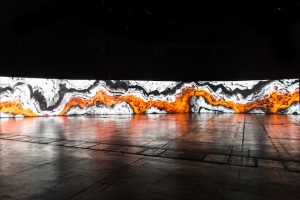vib-ribbon is a rhythm game created in 1999 by Masaya Mastuura, a Japanese musician and game designer. The game was one of 14 to be exhibited in the first MOMA collection of interactive media. The game functions by using player selected music to generate levels: obstacles and landscapes are generated using the sound waves of whatever music is playing in the game.
Personally, I really like the game’s visual style and innovative use of semi-random generation, which was decidedly ahead of its time. I think the game exhibits a willingness to experiment that most video games would shy away from. Both the visual style and use of musical level generation also speak to the Masturaa’s artistic sensibility: the game is clearly inspired by vector graphics, and the abstract-cartoonesque character design owes a lot to the work of artists like Takashi Murakami.
I don’t know exactly how the algorithms in the game work but here’s my guess: since computers can visualize sound waves, and each point of articulation of a sound wave has certain numerical values associated with it, the game probably generates simple shapes based on those values.
![[OLD – FALL 2016] 15-104 • COMPUTING for CREATIVE PRACTICE](../../../../wp-content/uploads/2020/08/stop-banner.png)


